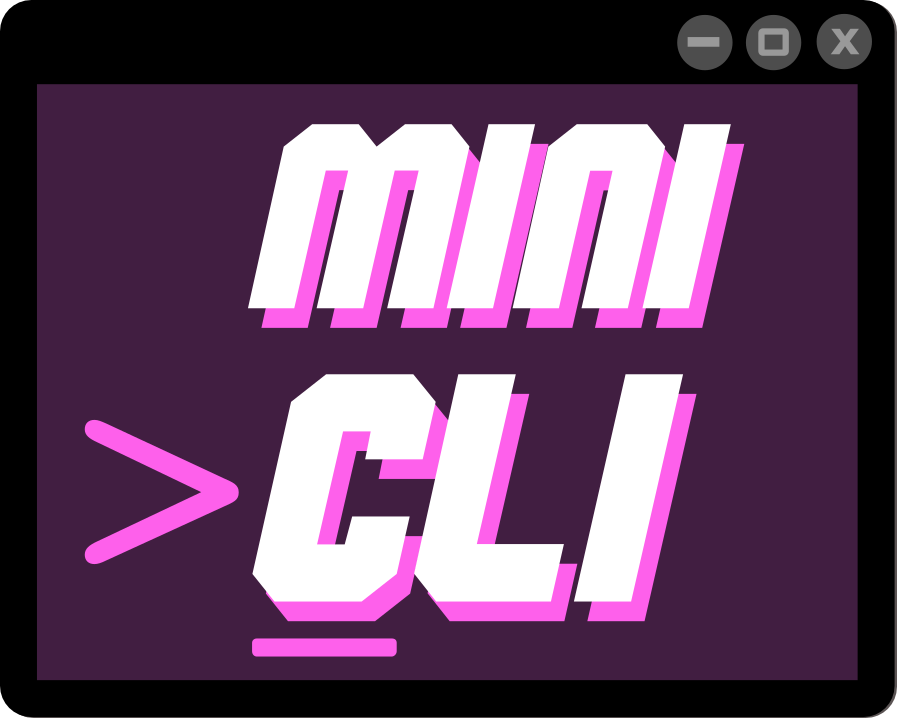https://github.com/minicli/minicli
A minimalist framework for command-line applications in PHP
https://github.com/minicli/minicli
cli command-line command-line-tools hacktoberfest php
Last synced: 7 months ago
JSON representation
A minimalist framework for command-line applications in PHP
- Host: GitHub
- URL: https://github.com/minicli/minicli
- Owner: minicli
- License: mit
- Created: 2019-09-20T14:58:30.000Z (about 6 years ago)
- Default Branch: main
- Last Pushed: 2025-04-08T18:59:25.000Z (8 months ago)
- Last Synced: 2025-05-07T20:03:46.055Z (7 months ago)
- Topics: cli, command-line, command-line-tools, hacktoberfest, php
- Language: PHP
- Homepage: https://docs.minicli.dev/
- Size: 312 KB
- Stars: 1,063
- Watchers: 19
- Forks: 58
- Open Issues: 9
-
Metadata Files:
- Readme: README.md
- Contributing: CONTRIBUTING.md
- Funding: .github/FUNDING.yml
- License: LICENSE.md
- Code of conduct: CODE_OF_CONDUCT.md
Awesome Lists containing this project
- awesome-php - Minicli - Minimalist, dependency-free framework for building CLI-centric PHP applications. (Table of Contents / Micro Frameworks)
- awesome-cli-frameworks - minicli - line applications in PHP. ([PHP](https://www.php.net/) / Useful awesome list for Go cli)
- fucking-awesome-php - Minicli - Minimalist, dependency-free framework for building CLI-centric PHP applications. (Table of Contents / Micro Frameworks)
README

Minicli
Minimalist, dependency-free framework for building CLI-centric PHP applications
[Minicli](https://docs.minicli.dev) is a minimalist, dependency-free framework for building CLI-centric PHP applications. It provides a structured way to organize your commands, as well as various helpers to facilitate working with command arguments, obtaining input from users, and printing colored output.
Quick links:
- [Documentation](https://docs.minicli.dev)
- [Demos](https://github.com/minicli/demos)
- [Contributing](CONTRIBUTING.md)
- [Contributors](CONTRIBUTORS.md)
## Dependency-free: What Does it Mean
What does it mean to be dependency-free? It means that you can build a working CLI PHP application without dozens of nested user-land dependencies. The basic `minicli/minicli` package has only **testing** dependencies, and a single system requirement:
- PHP >= 8.1
> Note: If you want to obtain user input, then the [`readline`](https://www.php.net/manual/en/function.readline.php) PHP extension is required as well.
It gives you a lot of room to choose your own dependencies.
## Getting Started
There are two ways to get started. If you want the bare minimum, what we'll call "Minimalist App", you can create a single PHP script with your whole application. If you want a more structured application, with commands and subcommands, then you should use Command Namespaces to organize your commands into Controllers.
### Minimalist App
If you just want to set up a few simple commands to run through `minicli`, all you need to do is to create an `App` and register your commands as anonymous functions.
1. Create an empty project
2. Run `composer require minicli/minicli` - this will generate a new `composer.json` file.
3. Create a `minicli` script with the following content:
```php
#!/usr/bin/env php
setSignature('./minicli mycommand');
$app->registerCommand('mycommand', function(CommandCall $input) {
echo "My Command!";
var_dump($input);
});
$app->runCommand($argv);
```
Then, make it executable and run `minicli` with your command:
```bash
chmod +x minicli
./minicli mycommand
```
### Structured App (Recommended)
For a more structured application using Controllers and Services, it's best to use [Command Namespaces](https://docs.minicli.dev/en/latest/getting_started/creating-controllers/#creating-command-controllers).
Our [application template repository](https://github.com/minicli/application) is a great starting point / template to set up Minicli that way.
To create a new project using the `minicli/application` template, run:
```
composer create-project --prefer-dist minicli/application myapp
```
This will generate a directory structure like the following:
```
.
app
└── Command
└── Help
├── DefaultController.php
├── TableController.php
└── TestController.php
├── composer.json
├── docs
├── LICENSE
├── minicli
├── mkdocs.yml
└── README.md
```
Each directory inside `app/Command` represents a Command Namespace.
The classes inside `app/Command/Help` represent subcommands that you can access through the main `help` command.
You can now run the bootstrapped application with:
```bash
./minicli help
```
The [documentation](https://docs.minicli.dev) contains more detailed information about creating commands and working with output.
## Color Themes
Minicli supports the use of color themes to change the style of command line output. There is currently 3 built-in themes other than the default theme:
- **[Unicorn](https://docs.minicli.dev/en/latest/output/using-themes/#unicorn)**: a more colorful theme.
- **[Dalton](https://docs.minicli.dev/en/latest/output/using-themes/#dalton)**: a color-blind friendly theme.
- **[Dracula](https://docs.minicli.dev/en/latest/output/using-themes/#dracula)**: a popular dark theme.
To set the theme, pass in a configuration array with a `theme` value when initializing App in the script. Built-in themes need a leading `\` character:
```php
$app = new App([
'theme' => '\Unicorn'
]);
```
To use the default built-in theme, do not include the theme configuration setting, or set it to an empty string.
User-defined themes can also be created and defined in your project. In this case, set the theme name including its namespace without a leading `\`:
```php
$app = new App([
'theme' => 'App\Theme\BlueTheme'
]);
```
The above setting would use the following example theme:
```php
[ CLIColors::$FG_BLUE ],
'alt' => [ CLIColors::$FG_BLACK, CLIColors::$BG_BLUE ],
'info' => [ CLIColors::$FG_WHITE],
'info_alt' => [ CLIColors::$FG_WHITE, CLIColors::$BG_BLUE ]
];
}
}
```
User-defined themes only need to define styles which will override those in the default theme.
## Contributing
Contributions are very welcome! You can contribute with code, documentation, filing issues... Please refer to our [contributing doc](CONTRIBUTING.md) for more information on the contribution process and what we expect from you.
### Running the Test Suite
Minicli uses [Pest PHP](https://pestphp.com) as testing framework. Once you have all dependencies installed via `composer install`, you can run the test suite with:
```bash
./vendor/bin/pest
```
To obtain the code coverage report, you'll need to have `xdebug` installed. Then, you can run:
```bash
./vendor/bin/pest --coverage
```
And this will give you detailed information about code coverage.
## Building Minicli
The following tutorials on [dev.to](https://dev.to/erikaheidi) compose a series named "Building Minicli", where we create `minicli` from scratch:
- Part 1: [Bootstrapping a CLI PHP Application in Vanilla PHP](https://dev.to/erikaheidi/bootstrapping-a-cli-php-application-in-vanilla-php-4ee) [ [minicli v.0.1.0](https://github.com/erikaheidi/minicli/tree/0.1.0) ]
- Part 2: [Building minicli: Implementing Command Controllers](https://dev.to/erikaheidi/php-in-the-command-line-implementing-command-controllers-13lh) [ [minicli v.0.1.2](https://github.com/erikaheidi/minicli/tree/0.1.2) ]
- Part 3: [Building minicli: Autoloading Command Namespaces](https://dev.to/erikaheidi/building-minicli-autoloading-command-namespaces-3ljm) [ [minicli v.0.1.3](https://github.com/erikaheidi/minicli/tree/0.1.3) ]
- Part 4: [Introducing minicli: a microframework for CLI-centric PHP applications](https://dev.to/erikaheidi/introducing-minicli-a-microframework-for-cli-centric-php-applications-44ik)
_Note: Minicli has evolved a lot since that series was initially written, but that was the base for what Minicli is today._